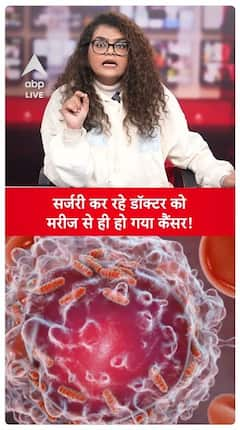Cervical Cancer Awareness Month: Screening Key To Catching It Early, Vaccine Aids Prevention
While medical experts continue to search for a cure, prevention and early detection to facilitate timely treatment can help people avoid the devastating effects of cervical cancer.

Cervical Cancer Awareness Month: Cervical cancer ranks fourth among the most commonly diagnosed cancers, as well as the fourth leading cause of cancer mortality, in women globally. According to the World Cancer Research Fund, China, India, and Indonesia had the highest number of cervical cancer cases and deaths in 2022.
While medical experts continue to search for a cure, prevention and early detection to facilitate timely treatment can help people avoid the devastating effects of cervical cancer.
A study by researchers from the Indian Council of Medical Research (ICMR)-National Centre for Disease Informatics and Research (NCDIR) — published in ‘Reproductive Health’ in July 2024 — states that cervical cancer is the second most common cancer in India. The study found a significant cervical cancer burden across the regions of India.
Researchers suggest that informative campaigns should be run for:
- Creating awareness about cervical cancer
- Advocating the significance of screening
- Promoting HPV vaccination among adolescents, families, and communities
These, they say, will prove to be the essential steps in managing cervical cancer in India.
Cervical Cancer Awareness Month
January is Cervical Cancer Awareness Month, an ideal chance for health authorities across the globe to raise awareness about cervical cancer and vaccination against the human papillomavirus (HPV), the main cause of cervical cancer.
Cervical cancer is one of the most successfully treatable forms of cancer, as long as it is detected early and managed effectively. Cancers diagnosed in late stages can also be controlled with appropriate treatment and palliative care.
The World Health Organization (WHO) aims that, with a comprehensive approach to prevent, screen and treat, cervical cancer as a public health problem can be ended within a few generations.
This Cervical Cancer Awareness Month, the message is clear:
- Get informed: Find out the facts about cervical cancer, its causes, and help educate other women in your life too
- Get screened: Cervical cancer screening typically starts at age 30 and is repeated periodically
- Get vaccinated: The HPV vaccine is given in 2 doses that should begin when a girl is between 9 and 14 years old. The US CDC recommends that boys get the HPV vaccine between the ages of 11 and 12, but it can be started as early as age 9. The HPV vaccine can help reduce the risk of genital cancers and genital warts in men.
Dr Neha Kumar, senior consultant – gynaecologic oncology, Amrita Hospital, Faridabad, spoke to ABP Live about the major causes behind the high burden of cervical cancer in India, the lack of awareness, and lack of cervical screening, etc. Excerpts from the exchange:
ABP: What is a healthy cervix and how to ensure cervical health?
Dr Neha Kumar: Cervix is the lower part of the uterus which connects the body of the uterus to the vagina (birth canal).
A healthy cervix is one that is not associated with any longstanding foul-smelling vaginal discharge, contact bleeding and/or postmenopausal bleeding, and that which — when screened by cytology (Pap smear) and/or high-risk HPV (another test) — does not show any abnormal (precancerous/cancerous) cells.
Measures To Maintain Cervical Health
* HPV vaccination in adolescent girls and young women
* Regular screening with Pap smear and/or high-risk HPV
* Practising safe-sex practices by using condoms and avoiding multiple sexual partners
* Ensuring genital hygiene
* Taking a balanced diet rich in nutrients
* Avoiding smoking
ABP: What must one do to prevent cervical cancer?
Dr Neha Kumar: Cervix cancer is a preventable disease. The prevention programme includes HPV vaccination and cervical cancer screening.
The HPV vaccine protects against two high-risk strains — 16 and 18 — of HPV, responsible for 70% of cervical cancers. It is recommended in young girls between the ages of 11 and 12 years, and also in teens and young adults between the ages of 13 and 26 years of age.
HPV vaccination must go hand-in-hand with cervical cancer screening that detects changes in the cervix before the cancer develops. Cervical cancer screening is done in women aged 21 to 65 years. Even girls vaccinated with HPV vaccine need cervical screening when they grow up.
Women between the ages of 21 to 29 years must undergo a Pap smear every 3 years. After the age of 30 years, screening is done using a combination of HPV test with Pap (Co-test) every 5 years (preferred), or a Pap test every 3 years.
ABP: How to detect cervical cancer in early stages?
Dr Neha Kumar: A major cause of the high burden of cervical cancer in India is lack of awareness and lack of cervical screening. Because of lack of screening, many cases of cervical cancer are detected in advanced stages, leading to high mortality rates. Screening can find changes in the cervix before the cancer develops. It can also find cervical cancer early — when it has not spread, and is amenable to curative treatment. You can protect yourself against this cancer by getting a Pap test with or without an HPV test regularly.
About The Tests
The Pap test is a painless outpatient procedure done during a gynaecological examination. It is used to collect cells from the cervix so that they can be looked at under a microscope to find cancerous and pre-cancerous cells.
Human Papillomavirus (HPV) test is done to check for high-risk HPV (HPV strains associated with cervical cancer) infection in women. This is done by looking for the genetic material (DNA) of HPV on a sample of cells collected from the cervix.
It is usually done at the same time as a Pap smear, while screening women aged 30-65 years (also called co-testing). The HPV DNA test is not recommended in women under 30. That is because HPV infections are common in sexually active women in their 20s, and most of them clear on their own.
The Pap smear and HPV test require pathology and laboratory services that may not be available in all parts of our country, especially in the remote and rural areas. An effective way to screen women in these areas is by methods known as VIA (Visual Inspection with Acetic Acid) and VILI (Visual Inspection with Lugol’s Iodine).
These methods use substances like acetic acid and Lugol’s iodine to see changes in the cervix that can be detected by the naked eye. Using this, one can identify abnormalities in the cervix, if any, and such patients can be referred to district hospitals for cervical biopsies and further management.
Peripheral health workers can be trained to do VIA and VILI, and this can help broaden the cervical screening programme in India in order to reduce the incidence of this disease.
The writer is a senior independent journalist.
[Disclaimer: The information provided in this article is for general informational purposes only and is not intended as a substitute for professional medical advice, diagnosis, or treatment. Always seek the advice of your physician or other qualified healthcare provider with any questions you may have regarding a medical condition or health concern.]
Check out below Health Tools-
Calculate Your Body Mass Index ( BMI )
Trending News
Top Headlines








































